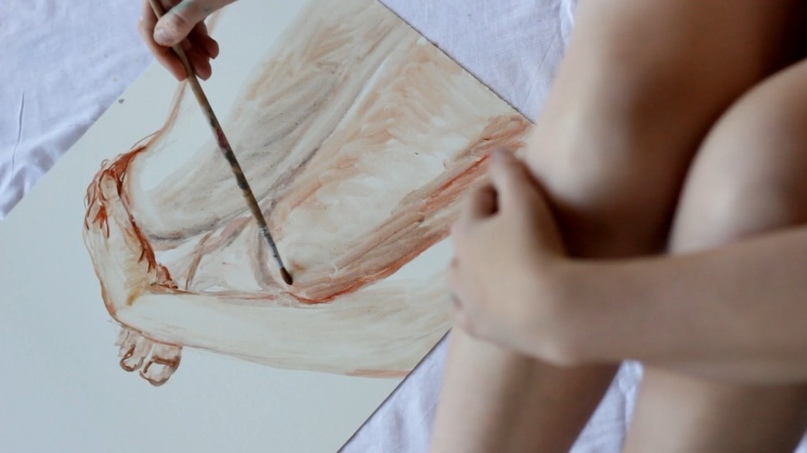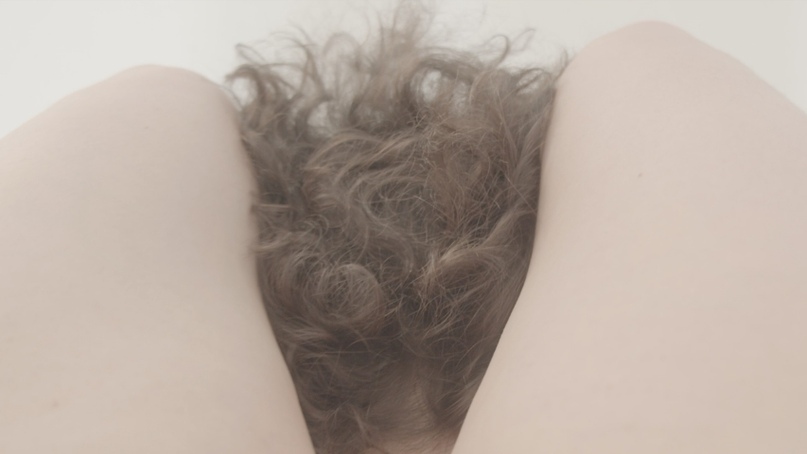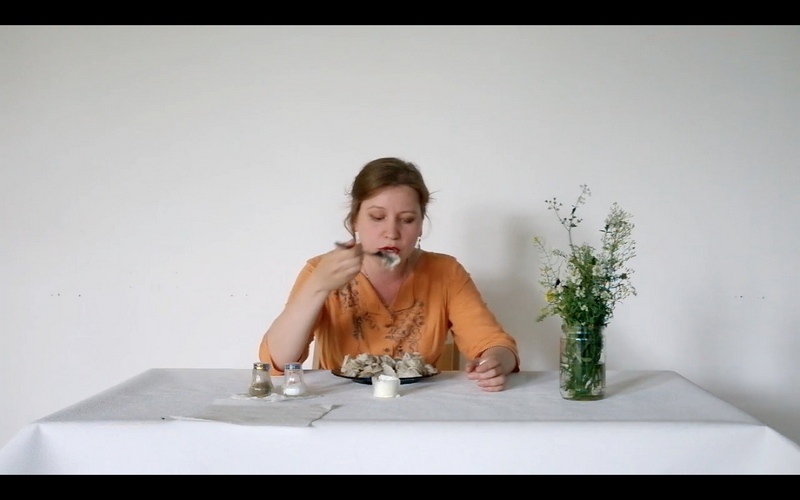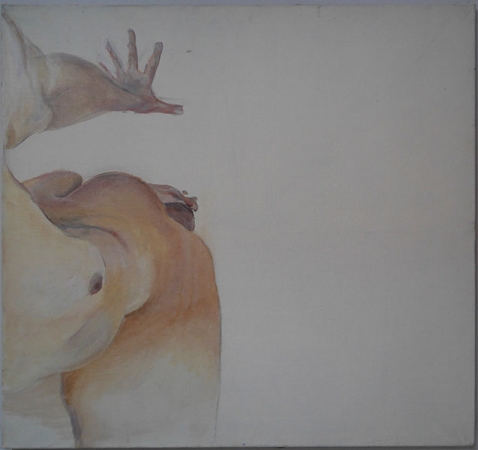Alena Tereshko, the author of unforgettable video works and performances exploring topics of identity, physicality and social adaptation. She shared with us some secrets of how her projects appear and how difficult it can be to put the context from personal into public.
Alyona graduated from the St Petersburg Art and Industry Academy of A. L. Stieglitz (2013) and School of the Young Artist ProArte (2013). Alena Tereshko is a member of the Parasit art group since 2012. Her works have been exhibited at the Russian Museum and were shown at the Short Film Festival in Oberhausen, at the New Media Center, New York. She is a laureate of the S. Kuryokhin Prize in the Media nomination in 2017.
What influenced the choice to work with personal topics?
Everything somehow went on its own. During my studying, for example, I had to make a “composition” (creative work), and I involuntarily wondered: what is it about? I had to find some topic to lean on. Otherwise, it resembled an endless training on a method.
Then I began trying. In many ways I relied on people’s reaction, on how they perceive my work, what they see and what they don’t, what they catch and what they don’t. You can think of a lot things that you want to put in your work, but in fact, none of this can be read. And it turned out that they understand me best when I do work based on my own experience. And the most direct way to express it happened to be performance.
But this personal experience is very limited, and so we resort to philosophy, literature, history, as a generalized experience, more universal. While reading a book or listening to a lecture, I try to understand and build this new knowledge in my experience, compare it with myself, make friends with it, and place it into my heart. As an artist I see my task not in illustrating a text or idea, but in living it through. Then there is a synthesis of what is outside with what is inside.
Do you have the fear of public “exposure”: to talk about personal things, to share thoughts. You don’t know how this will be perceived by the audience, do you?
My first performances were a great luck. I remember that there was fear at first, since I expected a worse reaction. But contrary to my expectations, I always found in people more understanding, openness and more warmth. At that time it gave me confidence and determination. Obviously there were different cases, and also unpleasant ones. Now I recall them less.
Despite the fact that viewers see what my work is about, they can perceive it in completely different ways. I faced diametrically opposite impressions of the same work. She provoked: laughter, compassion, aesthetic pleasure, and vice versa, disapproval and rejection. It’s a great present for me to listen to the comments and thoughts of the audience, because they become part of the work and moves me forward.

How do you get in the mood for performances? How difficult is it for you?
On the one hand, it’s always difficult. But there is also some kind of enthusiasm. It often happens that I have an idea and it won’t let go until you do it.
There are these awe-inspiring remarks: "you used to make good performances, but now you are so-so." What can I say? Maybe, but this is a necessity to think, to express it, and it is impossible to stop.
And after the performance, the debriefing begins: what it was, and how it looked, where the place to it, what it means. I begin to live with this, and careful thinking begins.

And where do you think these obsessive thoughts, of making performance and etc., come from?
Sometimes it is very personal and important for me at the first place. Sometimes I don’t even know what the idea is, it’s just important for me to do this. Sometimes I analyze everything for a long time and then do it. Just like the latest performance, for example, (performance “This Apple”: I really like to draw and I wanted to share this experience. I wasn’t solving any personal problems there, I was rather interested in how people would perceive it, if I transfer personal context — when I paint in the studio — into public. To see where the difference will be if I bring my personal drawing experience to the public field.
For example, you can sit and swing your leg at home for a very long time and have some feelings, and when you shoot it and show in public, you will experience completely different feelings.
performance “Just my own”
performance “This Apple”
And what changes when you transform personal into public?
At this moment, somehow you begin to understand yourself and others better. Your question and thinking are taking shape, as if they were an object. Other people can judge it; it no longer belongs to you, since you offer to share it with others, to make it mutual.
Tell us more about how it is when you have an idea, but don’t know what the result will be.
For example, my first performance “Girl from the Urals”. I didn’t know exactly what it was all about. It was just observations and feelings that I wanted to bring together and somehow present them, to speak them out: the day and the time were agreed, the topic was stated, so to speak, and it was no longer possible to leave or stop. During the performance, I felt something happening, I felt I was realizing something. And at that moment there was a feeling of liberation or straightening. As if you were in a complex of difficult insoluble problems and questions: traditions, family, desire to get married, dissatisfaction with relationships, and so on. Everything fell into place, and clarity came.
performance “Girl from the Urals”

performance “Girl from the Urals”
What were the toughest incidents on your performances?
There were a lot of incidents. I believe that every performance should contain an opportunity for casual situations. Also, when the performance is held with the audience, it complicates the matter greatly, because people react very differently, and their reaction is immediately included in the performance. For example, there was a performance called “Over Soulness” in the Square gallery. My friend and I attached a lot of balloons to our clothes and were going to hug people in the way that the balloons would burst. With my friend everything went according to the plan, but not with me. There was a viewer who took some kind of needle or something and burst all my balloons in 30 seconds, which deafened me. I didn’t expect that and was very confused. But any result is a result.

Alena Tereshko, from the "Field" series. Canvas, oil. 2015
Do you have any internal limitations?
No. There were performances that were hard to decide to, because common sense was telling me it was unwise or might hurt someone; sometimes it even seemed immoral to me: like the performance “Envy”. For some reason, I made it anyway, although there was a big scandal with my mother after these “pussies”. And I still think it did make sense, and that it saved me from big problems.
In some projects there is a feeling that you should do it. So I never regretted it later. I had no actual options, because I was tortured by this issue. I think it's good when there are such insoluble questions. In my experience, this is precisely the creative potency, the main engine in general. We must try to hear it in ourselves, to have certain intuition. To ask ourselves: why do I think that this is not OK, or what exactly is not OK. Usually this is the most important thing that people need to say.

Ph: Alexander Lavrentyev
BLITZ
1. The most valuable advice from your grandparents.
- From my grandmother, not particularly advice, more like parting words: sit at the table with your family as long as possible, because “while we are sitting at the table, we are in paradise”
2. What question would you like to answer yourself, but you’re never asked.
- Tell a story from your childhood (but actually sometimes they ask)
3. Tell us about your favorite place.
- Many favorite places in the Urals and in general wherever adventures have taken place. One sanatorium next to Lake Koshkul; I remember the smell there, smell of happiness: the sun and shady green and the coolness of the room. There was also a stained glass window and a fountain; it seems there was everything necessary for happiness.
4. Finish the phrase, “contemporary art is…
- Contemporary art is two words: the first speaks about its connection with the world today, and the second - about eternity and beauty.
5. What kind of gymnastics do you do?
- Different: sometimes this, sometimes that.
site